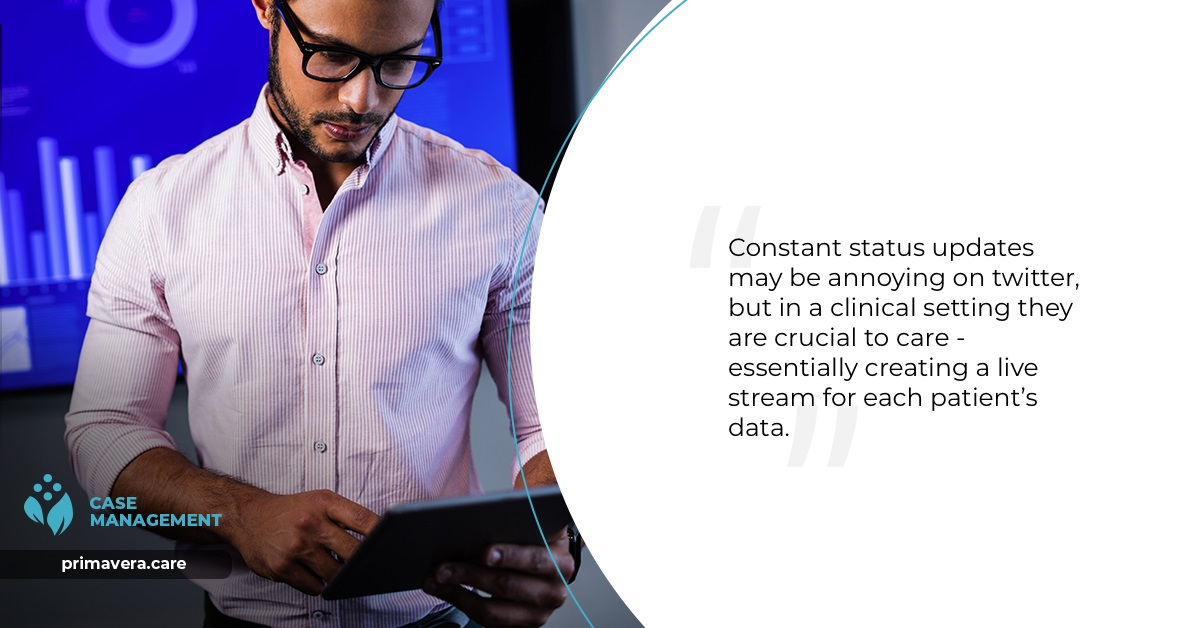Case management has always been a collaborative integration of patient care services; care coordination, facilitation, and advocacy.
At its core, case management is communication based – relying on the awareness and information exchange between practitioners, patients, and other providers. In our modern world, the added layer of apps and endless pathways of connection are influencing the healthcare continuum in a surprising way. As the technologies expand case management becomes more community based as a result.
It seems counterintuitive. So, How does it work? How does streamlining case management with more tech and telehealth lead to greater individualised care?
A Quick History of Case Management
Financially, case management systems are structured to provide the most benefits when the patient is at their healthiest. Case managers work to strike a balance that suits both the medical needs of the patient and the payment requirements of the providers and reimbursement sources. That’s a hard balance to strike.
Historically, case management processes began as community-based solutions to manage the care programming for patient populations in the psychiatric and social work settings of the 1920’s. This involved patient advocacy, and networking among the healthcare community to create channels for coordinated care.
The Timeline
From the 20’s through the 1980’s, case management remained in community settings – much of it driven by nurses and centering around university nursing programs (Yale), and a focus on behavioral work with WWII Veterans.
The 1980’s and 90’s saw legislation to integrate case management on a larger scale, making medicare and medicaid waivers available to support cost. This brought about a surge of activity and expansion as case management moved into hospitals and acute care. But it was primarily run as an extension of nursing services.
Where Are We Now?
After its integration into the hospital setting, case management caught like wildfire as other systems bought into the processes and expanded the services. Popularity equals power. Now, case management departments are no longer seen as systemic programs, but physical organizations present in all communities and healthcare sectors. That brings about a whole new set of challenges. And also brings us to the critical role of telehealth.
Rise of Telehealth: Influence on Case Management
As technology has progressed, case management systems have adapted. They expanded from small sectors to the epicenter of hospital infrastructure. Then they came full circle with a return to community based approaches as case management has spread throughout the healthcare continuum from social work all the way to massage therapy.
What are the Challenges Today?
The main challenge is clarification. Case management encompasses a minimum of:
- Basic Patient Care
- Specialized Care
- Transportation
- Client Intake & Records
- Insurance Providers
- Government Programming
- Patient Advocacy & Funding
Take that list and apply it just to the patient population of a single hospital. Now you can begin to see the critical importance of organization and communication.
Telehealth offers communication and data support to the growth of case management.
Benefits of Telehealth for Case Management
Intuitive Case Management
Primavera provides real-time, live feeds from hospitals bringing a new level of tracking and management to patient populations. Constant status updates may be annoying on twitter, but in a clinical setting they are crucial to care. These alerts essentially create a live stream for each patient’s data.
Instant information also promotes a greater connection between practitioners and patients by putting pertinent records at the fingertips of those who need to access it most. While data analysis gives way to prioritizing care to the patients with the greatest need, and algorithms work to analyze all data and prioritize tasks based on urgency.
Synchronizing Data
It’s great to have live feeds from hospitals but that’s not enough to get the full picture. Data synchronization combines access to the patient’s entire care history and records in one central hub. Additionally, it loops in a tracking element for activities like transportation, prescriptions, and payment.
Clarifying Roles
One of the biggest hurdles has been clarifying roles among all of the case workers, practitioners, offices, providers, and financial institutions. The patient care continuum is much like the space/time continuum – ever expanding and constantly confusing.
A Telehealth program acts as a guide, structuring the communication process by offering ways to assign roles clearly, follow up on responsibilities, and map out a plan on one scheduling platform that all contributors can access – including the patient.
Risk Management
Commit these two words to memory; predictive data. Ai and algorithms play a big part in all of our technologies from our social engagements to our shopping habits. Telehealth can bring a smart interpretation of that phenomena to your risk management by combining prioritized tasks, patient data, and statistical information to create a hierarchy of urgency within your practice.
Combine that structure with an element of constant updating of new information, and the end result is a science-backed care strategist that can fit in the palm of your hand.
Consistency without Compromise
As patient populations grow we need to remind ourselves that case management is about preventive care. So, analysis is important to establish each patient’s individual baseline and bring them up as much as possible through an inclusive care program that benefits all.
Consistency is a key player – by simplifying the case management structure and putting data on a secure platform. At that point, accessibility is increased which switches the focus from the process back to the patient. In this way, a widespread simplification of the tech boosts care to each individual patient.
Return to Community
Let’s sum this up.
Real time information, live feeds from hospitals, synchronization, and predictive data are all combined with updates and scheduling. From the patient’s perspective, this integrated backend is secondary to the open channels of communication, video calls, and easy access to care providers.
Primavera considers the administrative perspectives, business aspects, and patient experience to support needs of Practices from treatment to transportation. By making processes Easier Together we can continue to build a care-centered approach that doesn’t fall short of the demands of case management.
Don’t just take us at our word, schedule a demo today!








Recent Comments